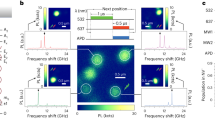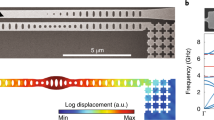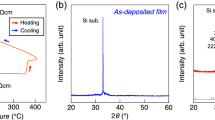Abstract
Present-day multimedia strongly rely on rewritable phase-change optical memories. We demonstrate that, different from the current consensus, Ge2Sb2Te5, the material of choice in DVD-RAM, does not possess the rocksalt structure but more likely consists of well-defined rigid building blocks that are randomly oriented in space consistent with cubic symmetry. Laser-induced amorphization results in drastic shortening of covalent bonds and a decrease in the mean-square relative displacement, demonstrating a substantial increase in the degree of short-range ordering, in sharp contrast to the amorphization of typical covalently bonded solids. This novel order–disorder transition is due to an umbrella-flip of Ge atoms from an octahedral position into a tetrahedral position without rupture of strong covalent bonds. It is this unique two-state nature of the transformation that ensures fast DVD performance and repeatable switching over ten million cycles.
This is a preview of subscription content, access via your institution
Access options
Subscribe to this journal
Receive 12 print issues and online access
$259.00 per year
only $21.58 per issue
Buy this article
- Purchase on Springer Link
- Instant access to full article PDF
Prices may be subject to local taxes which are calculated during checkout





Similar content being viewed by others
References
Moller, S., Perlov, C., Jackson, W., Taussig, C. & Forrest, S.R. A polymer/semiconductor write-once read-many-times memory. Nature 426, 161–169 (2003).
Ovshinsky, S.R. Reversible electrical switching phenomena in disordered structures. Phys. Rev. Lett. 21, 1450–1453 (1968).
Ohta, T. Phase-change optical memory promotes the DVD optical disk. J. Optoelectron. Adv. Mater. 3, 609–626 (2001).
Ohta, T. & Ovshinsky, S.R. in Photo-induced Metastability in Amorphous Semiconductors (ed. Kolobov, A.V.) 310–326 (Wiley-VCH, Berlin, 2003).
Petrov, I.I., Imamov, R.M. & Pinsker, Z.G. Electronographic determination of the structures of Ge2Sb2Te5 and GeSb4Te7 . Sov. Phys. Crystallogr. 13, 339–344 (1968).
Gonzalez-Hernandez, J. et al. Free carrier absorption in the Ge:Sb:Te system. Solid State. Commun. 95, 593–596 (1995).
Nonaka, T., Ohbayashi, G., Toriumi, Y., Mori, Y. & Hashimoto, H. Crystal structure of GeTe and Ge2Te2Te5 meta-stable phase. Thin Solid Films 370, 258–261 (2000).
Yamada, N. & Matsunaga, T. Structure of laser-crystallised Ge2Sb2+xTe5 sputtered thin films for use in optical memory. J. Appl. Phys. 88, 7020–7028 (2000).
Koningsberger, D.C. & Prins, R. (eds) X-ray Absorption (Wiley, New York, 1988).
Frenkel, A.I., Stern, E.A., Voronel, A., Qian, M. & Newville, M. Buckled crystalline structure of mixed ionic salts. Phys. Rev. Lett. 71, 3485–3888 (1993).
Littlewood, P.B. The crystal structure of IV-VI compounds: 1. Classification and description. J. Phys. C 13, 4855–4973 (1980).
Chattopadhyay, T., Boucherle, J.X. & von Schnering, H.G. Neutron diffraction study on the structural phase transition in GeTe. J. Phys. C 20, 1431–1440 (1987).
Kolobov, A.V., Tominaga, J., Fons, P. & Uruga, T. Local structure of crystallized GeTe films. Appl. Phys. Lett. 82, 382–384 (2003).
Privitera, S., Rimini, E., Bongiorno, C., Pirovano, A. & Bez, R. Crystallization and phase separation in Ge2+xSb2Te5 thin films. J. Appl. Phys. 94, 4409–4413 (2003).
Vengalis, B. & Valatska, K. Phase segregaton in Te saturated GeTe. Phys. Status Solidi B 117, 471–476 (1983).
Rabe, K.M. & Joannopoulos, J.D. Theory of the structural phase transition of GeTe. Phys. Rev. B 36, 6631–6639 (1987).
Tominaga, J. et al. Ferroelectric catastrophe: beyond nanometer-scale optical resolution. Nanotechnology 15, 411–415 (2004).
Wakagi, M., Ogata, K. & Nakano, A. Structural study of a-Si and a-Si:H films by EXAFS and Raman-scattering spectroscopy. Phys. Rev. B 50, 10666–10671 (1994).
Njoroge, W.K., Woltgens, H.W. & Wuttig, M. Density changes upon crystallization of Ge2Sb2.04Te4.74 films. J. Vac. Sci. Technol. A 20, 230–233 (2002).
Brodsky, M.H. in Light Scattering in Solids (ed. Cardona, M.) 205–252 (Springer, Berlin, 1983).
Kalb, J., Spaepen, F. & Wuttig, M. Calorimetric measurements of phase transformations in thin films of amorphous Te alloys used for optical data storage. J. Appl. Phys. 93, 2389–2393 (2003).
Yamada, N., Ohno, E., Nishiuchi, K., Akahira, N. & Takao, M. Rapid phase transitions of GeTe-Sb2Te3 pseudobinary amorphous thin films for optical disk memory. J. Appl. Phys. 69, 2849–2856 (1991).
Ovshinsky, S.R. in Insulating and Semiconducting Glasses (ed. Boolchand, P.) 729–780 (World Scientific, Singapore, 2000).
Angell, C.A. in Insulating and Semiconducting Glasses (ed. Boolchand, P.) 1–52 (World Scientific, Singapore, 2000).
Yassievich, I.A. Recombination-induced defect heating and related phenomena. Semicond. Sci. Technol. 9, 1933–1953 (1994).
Ankudinov, A.L., Ravel, B., Rehr, J.J. & Conradson, S. Real-space multiple-scattering calculation and interpretation of x-ray-absorption near-edge structure. Phys. Rev. B 58, 7565–7576 (1998).
Acknowledgements
The XAFS measurements were performed at beamlines 12C at the Photon Factory, Japan, and BL01B1 at SPring-8, Japan as parts of proposals 2001G332 and 2001B0099-NX, respectively. A.V.K. would like to thank A. S. Mishchenko for a useful discussion. A. I. F. acknowledges support by the US Department of Energy Grant No. DE-FG02- 03ER15477.
Author information
Authors and Affiliations
Corresponding author
Ethics declarations
Competing interests
The authors declare no competing financial interests.
Rights and permissions
About this article
Cite this article
Kolobov, A., Fons, P., Frenkel, A. et al. Understanding the phase-change mechanism of rewritable optical media. Nature Mater 3, 703–708 (2004). https://doi.org/10.1038/nmat1215
Received:
Accepted:
Published:
Issue Date:
DOI: https://doi.org/10.1038/nmat1215
This article is cited by
-
Reversible non-volatile electronic switching in a near-room-temperature van der Waals ferromagnet
Nature Communications (2024)
-
Phase-change materials based on amorphous equichalcogenides
Scientific Reports (2023)
-
Study on the Crystallization Behavior of Sb2Te Thin Films for Phase-Change Memory Applications
Journal of Electronic Materials (2023)
-
In-memory computing based on phase change memory for high energy efficiency
Science China Information Sciences (2023)
-
Structural Transformation of Thin Ge2Sb2Te5
Films Produced by Ion-Plasma Co-Sputtering Under Laser Irradiation Journal of Electronic Materials (2023)



